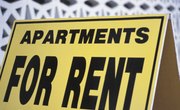Property owners in California have the ability to offer property for rent to tenants. The landlord tenant law in California protects the property owner and the tenant involved in this type of relationship. The state also requires a property owner to maintain the property, follow the law in regards to eviction, security deposits and lease agreements.
Security Deposits
California law allows a landlord to require a security deposit from tenants when renting a residence. For an unfurnished residence, the landlord may require up to two times the amount of the rent. In furnished rental units, the landlord may require three times the rent for a security deposit.
The landlord must allow the tenant to have a walk-through of the apartment or rental unit at least two weeks before moving out of the residence. The walk-through allows the tenant to fix damages the landlord finds in the residence. Property owners must return the security deposit to the tenant within three weeks after the tenant moves out of the residence. When the landlord uses the security deposit to repair the property or for unpaid rent he must send the tenant a listing of the expenses. California law does not allow landlords to charge tenants for painting, curtains or carpet.
Lease Agreements
Landlords can enter into a rental agreement or a lease in the state of California. A rental agreement can be oral or written. The rental agreement determines the length of the rental period such as a monthly tenancy. A rental agreement ends at the end of the rental period and renews when a new rent payment is made. A lease determines in advance the length of time that the agreement is in effect such as in a yearly lease. Tenants are responsible for the entire term of the lease, but landlords may not raise the rent unless it is specified in the lease. Landlords can include rules for tenants using the property such as pet policy, number of tenants living in the unit, responsibility for utilities and the name and address of the person receiving the rent payments.
Landlord Obligations
In California, landlords are obligated to provide tenants with a livable residence. The landlord is responsible for ensuring the unit has plumbing, hot and cold running water, electricity, trash cans, heat, smoke detectors, security devices and locks for windows and main doors, fire exits, working windows and natural light in each room. The unit must also be weatherproof and free of pests. Railings and stairways must be safe, as well.
Eviction Process
Landlords have the right to use the eviction process to remove tenants who fail to pay rent or violate the lease agreement. Landlords must use the legal eviction process and cannot use self-help measures such as locking the tenant out or turning off utilities to force a tenant out of the residence.
References
- Joint Center for Housing Studies at Harvard University. "America's Rental Housing 2020," Page 9. Accessed March 20, 2020.
- Nolo. "State Laws on Landlord's Access to Rental Property." Accessed March 20, 2020.
- Nolo. "How Evictions Work: Rules for Landlords and Property Managers." Accessed March 20, 2020.
- U.S. Department of Housing and Urban Development. "Housing Discrimination Under the Fair Housing Act." Accessed March 20, 2020.
Writer Bio
Luanne Kelchner works out of Daytona Beach, Florida and has been freelance writing full time since 2008. Her ghostwriting work has covered a variety of topics but mainly focuses on health and home improvement articles. Kelchner has a degree from Southern New Hampshire University in English language and literature.

